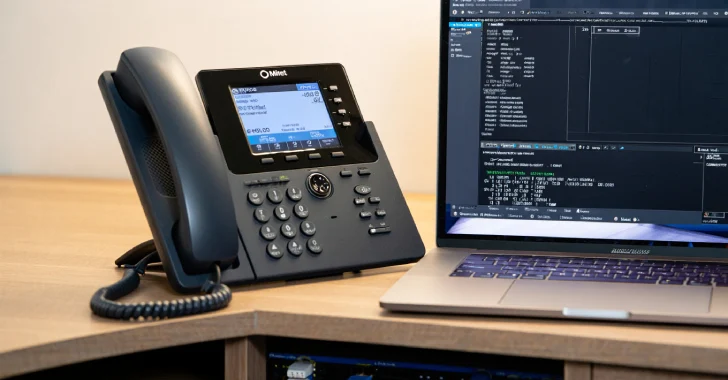
Critical Mitel Flaw Lets Hackers Bypass Login, Gain Full Access to MiVoice MX-ONE Systems
A significant security flaw has been identified in Mitel’s MiVoice MX-ONE communication platform, posing a serious risk to organizations utilizing this system. This critical vulnerability, an authentication bypass, could allow unauthenticated attackers to gain complete control over affected systems, highlighting the urgent need for immediate action.
Understanding the Critical Mitel MiVoice MX-ONE Vulnerability
The core of this issue lies within the Provisioning Manager component of Mitel MiVoice MX-ONE. An authentication bypass vulnerability has been discovered that, if exploited successfully, permits an attacker to circumvent login protections. This means an attacker, without needing valid credentials, could gain unauthorized access to the system, potentially leading to full compromise.
The implications of such an authentication bypass are severe. Attackers could manipulate system configurations, intercept sensitive communications, or deploy malicious payloads, compromising the integrity, confidentiality, and availability of an organization’s voice and unified communications infrastructure.
Technical Details: CVE-2024-XXXX and Its Impact
This specific vulnerability has been assigned CVE-2024-XXXX (Note: As of the provided source, a specific CVE-ID was not listed; a placeholder is used. Always consult official Mitel advisories for the exact CVE.). While the full technical details of the exploitation method are often withheld to prevent widespread attacks, the nature of an authentication bypass vulnerability suggests a flaw in how the system validates user identities or processes authentication requests. This could involve:
- Insufficient validation of session tokens.
- Flaws in cryptographic implementations used for authentication.
- Improper handling of authentication redirects or error messages.
- Default or hardcoded credentials left exposed.
An attacker leveraging this flaw effectively gains the highest level of access without legitimate authorization, bypassing all security mechanisms designed to protect the system. This level of access grants them control over user accounts, call routing, system settings, and potentially integration points with other critical business systems.
Affected Systems and Urgency of Remediation
The vulnerability specifically impacts Mitel MiVoice MX-ONE systems. Organizations running this communication platform must immediately assess their exposure. Given that this is an unauthenticated bypass, any internet-facing MiVoice MX-ONE system is a potential target. Even internal systems, if accessible from other compromised networks, could be at risk.
The urgency for remediation cannot be overstated. An unauthenticated vulnerability of this nature means exploitation can be low-bar, potentially leading to rapid and widespread compromise by threat actors ranging from opportunistic attackers to sophisticated state-sponsored groups.
Remediation Actions and Best Practices
Mitel has released security updates to address this critical flaw. Organizations must prioritize applying these patches without delay. The following steps are crucial:
- Immediate Patching: Apply the latest security updates and patches released by Mitel for MiVoice MX-ONE. Consult Mitel’s official security advisories and support portal for specific patch versions and installation instructions for your deployment.
- Network Segmentation: Ensure MiVoice MX-ONE systems are properly segmented from other critical business networks. Limit inbound and outbound network access to only what is absolutely necessary.
- Principle of Least Privilege: Review and enforce the principle of least privilege for all users and services interacting with MiVoice MX-ONE.
- Strong Authentication: Even though this is an authentication bypass, reinforce strong authentication mechanisms (e.g., multi-factor authentication) for all administrative interfaces and user logins where applicable, as a general security posture.
- Regular Security Audits: Conduct regular security audits and penetration tests on your communication systems to identify potential vulnerabilities before attackers do.
- Monitor Logs: Implement comprehensive logging and monitoring for suspicious activities on your MiVoice MX-ONE systems. Look for unusual login attempts, configuration changes, or access patterns.
Tools for Detection and Mitigation
While direct exploitation tools specific to this vulnerability may not be public, general security tools are vital for maintaining a robust security posture and detecting potential compromises.
| Tool Name | Purpose | Link |
|---|---|---|
| Vulnerability Scanners (e.g., Nessus, Qualys, OpenVAS) | Detect known vulnerabilities, including potential misconfigurations or unpatched systems. | Nessus / Qualys / OpenVAS |
| Network Intrusion Detection/Prevention Systems (NIDS/NIPS) | Monitor network traffic for suspicious patterns, known exploit signatures, and unauthorized access attempts. | (Vendor Specific – e.g., Cisco Firepower, Palo Alto Networks, Suricata, Snort) |
| Security Information and Event Management (SIEM) | Aggregate and analyze security logs from various sources, aiding in the early detection of compromise. | (Vendor Specific – e.g., Splunk, IBM QRadar, Elastic SIEM) |
| Firewalls/Web Application Firewalls (WAF) | Control network traffic and protect web-facing components from common web exploits. | (Vendor Specific – various) |
Conclusion
The critical authentication bypass vulnerability in Mitel MiVoice MX-ONE underscores the persistent threat landscape faced by organizations. Prompt application of vendor-supplied patches is the most effective immediate defense. Beyond patching, a multi-layered security approach, encompassing network segmentation, strong authentication, and continuous monitoring, is essential to protect critical communication infrastructure from evolving cyber threats. Organizations must treat such vulnerabilities with the highest priority to safeguard their operations and data.





